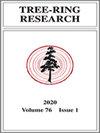Dendroecological Approach to Assessing Carbon Accumulation Dynamics in Two Pinus Species from Northern Mexico
IF 1.1
4区 农林科学
Q3 FORESTRY
引用次数: 8
Abstract
Abstract Global climate change will alter forests by shifting species ranges, which has implications for their ecological functions. Annual tree-ring widths and wood density are useful proxies for carbon cycle studies across a range of species. Here, using a dendroecological approach we sought to understand the carbon accumulation rates of two representative pine species growing on contrasting wet (P. arizonica) and dry (P. cembroides) sites and reveal how such species cope with climate variability. Although the rate of carbon gain was not significantly different across sites, we found that variations in carbon accumulation responded differently to specific hydroclimate drivers, site conditions, or to functional features of each species, which are still to be explored. Overall, annual carbon accumulation (C) was less sensitive to climate variability than ring width and wood density. Annual C was more sensitive to rainfall in the cold season (P. arizonica) and to the start of spring (both species). Our species-specific approach provided a suitable basis for modeling projections in the long-term carbon balance in these forests. Using species-specific tree-ring data has the potential to yield better estimations given that tree rings reflect fine spatial and temporal resolution, thereby reducing the uncertainty in forest carbon budgets.用松生态学方法评估墨西哥北部两种松树的碳积累动态
摘要全球气候变化将通过改变物种范围来改变森林,这对其生态功能有影响。年轮宽度和木材密度是一系列物种碳循环研究的有用指标。在这里,我们使用树木生态学方法,试图了解生长在潮湿(P.arizonica)和干燥(P.cembroides)的两个代表性松树物种的碳积累率,并揭示这些物种如何应对气候变化。尽管不同地点的碳增长率没有显著差异,但我们发现,碳积累的变化对特定的水文气候驱动因素、地点条件或每个物种的功能特征的反应不同,这一点仍有待探索。总的来说,年碳积累(C)对气候变化的敏感性不如环宽度和木材密度。年C对寒冷季节的降雨量(P.arizonica)和春季开始(两个物种)更敏感。我们针对物种的方法为这些森林的长期碳平衡预测建模提供了合适的基础。使用特定物种的树木年轮数据有可能产生更好的估计,因为树木年轮反映了精细的空间和时间分辨率,从而减少了森林碳预算的不确定性。
本文章由计算机程序翻译,如有差异,请以英文原文为准。
求助全文
约1分钟内获得全文
求助全文
来源期刊

Tree-Ring Research
农林科学-林学
CiteScore
2.40
自引率
12.50%
发文量
15
审稿时长
>36 weeks
期刊介绍:
Tree-Ring Research (TRR) is devoted to papers dealing with the growth rings of trees and the applications of tree-ring research in a wide variety of fields, including but not limited to archaeology, geology, ecology, hydrology, climatology, forestry, and botany. Papers involving research results, new techniques of data acquisition or analysis, and regional or subject-oriented reviews or syntheses are considered for publication.
Scientific papers usually fall into two main categories. Articles should not exceed 5000 words, or approximately 20 double-spaced typewritten pages, including tables, references, and an abstract of 200 words or fewer. All manuscripts submitted as Articles are reviewed by at least two referees. Research Reports, which are usually reviewed by at least one outside referee, should not exceed 1500 words or include more than two figures. Research Reports address technical developments, describe well-documented but preliminary research results, or present findings for which the Article format is not appropriate. Book or monograph Reviews of 500 words or less are also considered. Other categories of papers are occasionally published. All papers are published only in English. Abstracts of the Articles or Reports may be printed in other languages if supplied by the author(s) with English translations.
 求助内容:
求助内容: 应助结果提醒方式:
应助结果提醒方式:


